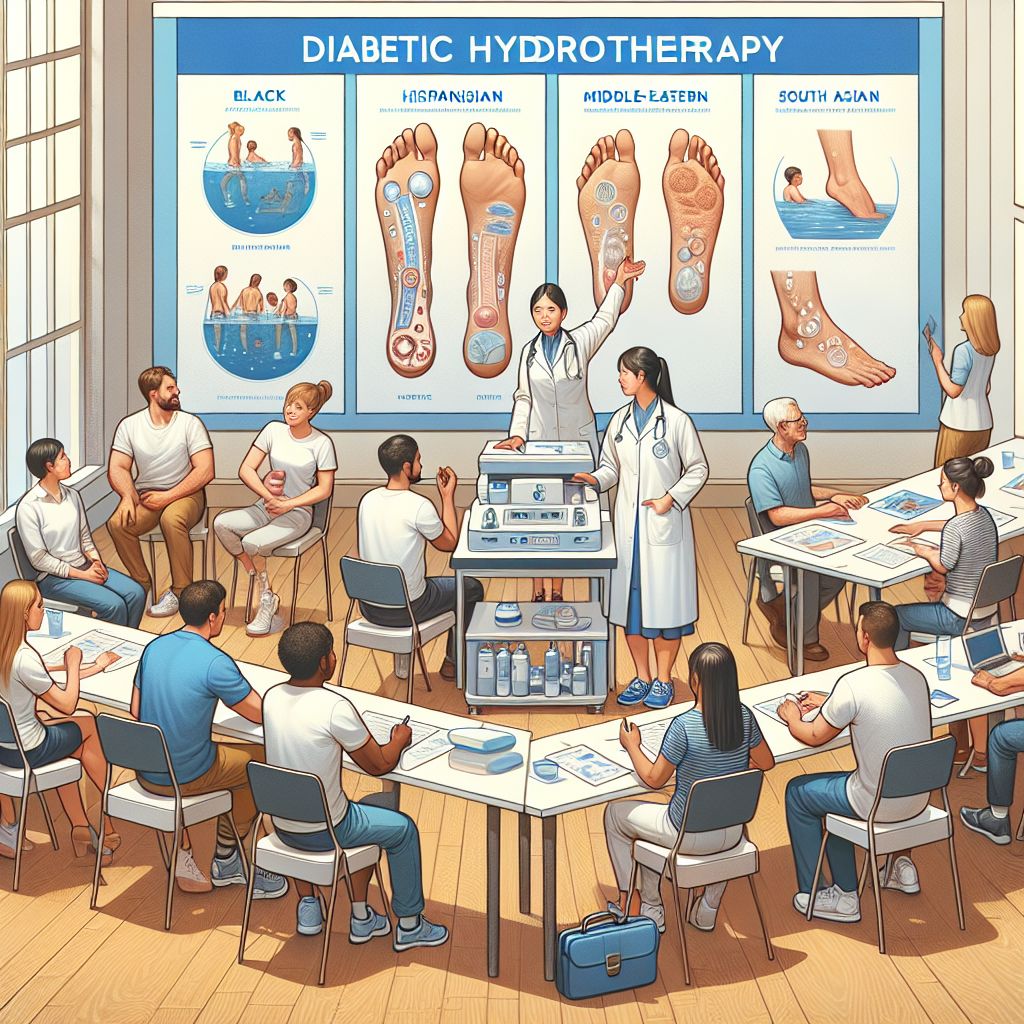
Key Takeaways
-
Hydrotherapy can improve blood circulation and reduce stress, which are key in managing diabetes.
-
Attending a diabetic hydrotherapy workshop equips you with techniques for better diabetes control and overall health.
-
Workshops provide a supportive environment where you can learn and practice hydrotherapy under expert guidance.
-
Regular hydrotherapy can lead to long-term benefits, including improved blood sugar levels and a stronger immune system.
-
Hydrotherapy is a complementary treatment, and it’s essential to continue your prescribed diabetes management plan.
Discover the Power of Water: How Hydrotherapy Aids Diabetes Management
Imagine a tool that could help manage your diabetes, not with more medication or restrictive diets, but with the soothing embrace of water. This isn’t a fantasy; it’s hydrotherapy. When you’re living with diabetes, managing blood sugar levels becomes a part of daily life. But there’s more to diabetes care than just monitoring glucose. It’s about holistic wellness—finding ways to improve your circulation, reduce stress, and enhance your overall health. That’s where hydrotherapy comes in.
Hydrotherapy, or water therapy, uses the physical properties of water—such as temperature and pressure—to stimulate blood flow and relax the mind and body. For individuals with diabetes, these effects can be particularly beneficial. Improved circulation helps with the efficient delivery of insulin and nutrients to cells, while the stress reduction can lower blood sugar levels indirectly by reducing the release of stress hormones like cortisol.
The Scientific Basis of Hydrotherapy for Blood Sugar Control
Let’s dive deeper into why hydrotherapy works. Water has a higher density than air, which means moving through water provides a gentle resistance that can help build muscle strength without the need for heavy weights. Stronger muscles can improve insulin sensitivity, which is crucial for managing diabetes. Moreover, the warmth of the water can increase blood flow, aiding in the healing of wounds—a common concern for those with diabetes.
Most importantly, the buoyancy of water reduces the impact on joints, making it an ideal form of exercise for people with diabetes who may also struggle with joint pain or mobility issues. This means you can exercise longer and more comfortably in water than on land, which can lead to better control of your blood sugar levels over time.
Hydrotherapy Techniques That Benefit Diabetics
There are several hydrotherapy techniques that can be especially beneficial for those managing diabetes:
-
Aquatic Aerobics: Low-impact exercises that improve cardiovascular health and boost metabolism.
-
Water-Based Relaxation: Techniques such as floating or gentle stretching that promote stress relief and mental well-being.
-
Hydro-massage: Using water jets to massage the body, which can stimulate circulation and aid in muscle recovery.
These techniques not only aid in managing diabetes but also contribute to an improved sense of well-being. When you feel better, you’re more likely to stay active and engaged in your diabetes care plan.
Joining Forces: The Role of Hydrotherapy Workshops in Diabetes Care

Now, you might be wondering, “How do I start with hydrotherapy?” That’s where diabetic hydrotherapy education workshops come into play. These workshops are designed to introduce you to the world of hydrotherapy and teach you how to use it to your advantage in managing diabetes.
Workshops are led by professionals who understand both hydrotherapy and diabetes management. They’ll guide you through the process, teach you about the benefits, and show you how to safely enjoy hydrotherapy. Plus, you’ll be in the company of others who are on the same journey as you, providing an opportunity for support and community.
Workshop Structure and What to Expect
When you sign up for a diabetic hydrotherapy workshop, you can expect a blend of education and hands-on practice. Here’s a typical workshop structure:
-
An introduction to hydrotherapy and its benefits for diabetes management.
-
Demonstrations of various hydrotherapy techniques.
-
Guided sessions where you can practice the techniques in a safe and controlled environment.
-
Discussions on how to incorporate hydrotherapy into your daily routine.
-
Personalized advice and modifications to suit your individual health needs.
These workshops are not just about learning in a classroom; they’re about experiencing the benefits firsthand. You’ll leave with a clear understanding of how to use water as a tool in your diabetes management toolkit.
Integrating Self-Care Practices with Medical Advice
One of the most important aspects of these workshops is learning how to integrate hydrotherapy with your current diabetes management plan. It’s not about replacing your medication or doctor’s advice; it’s about enhancing your overall care strategy.
Therefore, it’s crucial to maintain open communication with your healthcare provider about your hydrotherapy practices. They can help you understand how it fits into your broader care plan and ensure that all aspects of your health are being considered.
Remember, managing diabetes is a team effort, and you are the most important member of that team. By learning about and practicing hydrotherapy, you’re taking an active role in your care and empowering yourself to live well with diabetes.
Finding Balance: Techniques Learned in Hydrotherapy Workshops

Learning in a workshop is just the beginning. The real magic happens when you take those techniques and weave them into the fabric of your everyday life. The goal is to create a sustainable practice that not only manages diabetes but also enhances your overall quality of life.
After all, balance isn’t just about blood sugar levels; it’s about balancing all aspects of your life to create harmony and health. Hydrotherapy can be a key part of that balance.
Mindfulness and Relaxation in Aquatic Environments
During the workshops, you’ll be introduced to the concept of mindfulness in the water. This isn’t just about doing exercises; it’s about being present in the moment, feeling the water around you, and allowing the stress to melt away. This mindfulness can have a profound effect on your mental state and, in turn, your diabetes management.
Think about it this way: stress can raise your blood sugar levels, so by reducing stress through aquatic relaxation, you’re taking a proactive step in managing your diabetes. Plus, the skills you learn here can be applied outside of the pool, helping you to maintain a calm and centered approach to life’s challenges.
Building a Personal Hydrotherapy Routine
One of the most empowering parts of a diabetic hydrotherapy workshop is learning how to build your own hydrotherapy routine. This personalized plan will take into account your fitness level, your diabetes management goals, and your personal preferences.
A typical routine might include:
-
Warm-up exercises to get your blood flowing.
-
Gentle aquatic exercises tailored to your ability level.
-
Relaxation techniques to calm your mind and reduce stress.
-
Cool-down stretches to keep your muscles flexible.
By the end of the workshop, you’ll have a clear idea of what a hydrotherapy session might look like for you. And the best part? You can adjust it over time as your needs and abilities change.
From the Experts: Education Workshop Highlights and Insights
The wisdom of experts who have seen the transformative power of hydrotherapy in action is an invaluable part of the learning experience. These professionals bring a wealth of knowledge about diabetes management and the role that hydrotherapy can play in it.
Success Stories: Participants Reflect on Their Progress
One of the most inspiring parts of the workshops is hearing from past participants. Their stories of improved blood sugar control, reduced reliance on medication, and enhanced quality of life serve as powerful testimony to the benefits of hydrotherapy.
Take, for example, John, who attended a workshop six months ago. He was skeptical at first, but after regularly incorporating hydrotherapy into his routine, he noticed his fasting blood sugar levels dropped by an average of 20 mg/dL. He also found that he was sleeping better and felt more energized throughout the day.
Expert Opinions on Ongoing Diabetes Self-Management
Experts agree that self-management is a cornerstone of diabetes care. Hydrotherapy workshops teach more than just exercises; they offer strategies for self-monitoring, nutrition, and integrating physical activity into daily life. These comprehensive approaches help individuals take control of their diabetes and their health.
Charting Progress: The Impact of Hydrotherapy Workshops on Health Outcomes
Attending a workshop is just the beginning. The true measure of success comes from the changes you see in your health over time. By applying what you’ve learned, you can chart a course towards better diabetes management and improved well-being.
Monitoring Improvements in Diabetic Symptoms Post-Workshop
-
Regularly checking blood sugar levels to see the direct impact of your hydrotherapy routine.
-
Noting improvements in wound healing, circulation, and energy levels.
-
Keeping track of weight changes, as hydrotherapy can help with weight management—a key factor in diabetes care.
-
Recording any changes in medication usage, with the guidance of your healthcare provider.
By keeping an eye on these indicators, you can see the tangible benefits of your efforts. And remember, it’s not just about the numbers; it’s about how you feel. Many people report feeling happier, less stressed, and more connected to their bodies after starting hydrotherapy.
So, if you’re looking for a way to take your diabetes management to the next level, consider exploring the world of hydrotherapy. It’s not just about getting wet; it’s about opening a new chapter in your journey towards
Frequently Asked Questions
1. Is Hydrotherapy Safe for All Diabetics?
Yes, hydrotherapy is generally safe for most people with diabetes. However, it’s always important to consult with your healthcare provider before starting any new exercise program, including hydrotherapy. They can advise you on any precautions you should take based on your individual health condition and diabetes management plan.
2. How Often Should I Engage in Hydrotherapy Sessions?
The frequency of hydrotherapy sessions can vary depending on your personal health goals and schedule. Most people find that participating in hydrotherapy 2-3 times per week provides significant benefits. Always listen to your body and adjust your routine as needed, and remember to continue your regular diabetes management practices.
3. Can Hydrotherapy Replace Other Forms of Diabetes Treatment?
Hydrotherapy should not replace your current diabetes treatments, such as medication or dietary control. Instead, think of it as a complementary therapy that can enhance your overall health and well-being. Always follow the diabetes management plan prescribed by your healthcare provider.
4. What Should I Wear for a Hydrotherapy Session?
Comfort is key during hydrotherapy sessions. Wear a swimsuit that allows you to move freely and is appropriate for exercise. If you’re sensitive to the cold, consider wearing a rash guard or swim shirt for additional warmth. Non-slip water shoes can also provide extra stability and safety.
5. Are There Any Age Limitations for Participating in Hydrotherapy Workshops?
Hydrotherapy is beneficial for individuals of all ages. However, specific workshops may have age recommendations or restrictions based on the activities involved. Check with the workshop provider for any age-related guidelines. If you’re concerned about your ability to participate due to age or mobility issues, discuss these with the workshop facilitator to accommodate your needs.



Leave a Reply